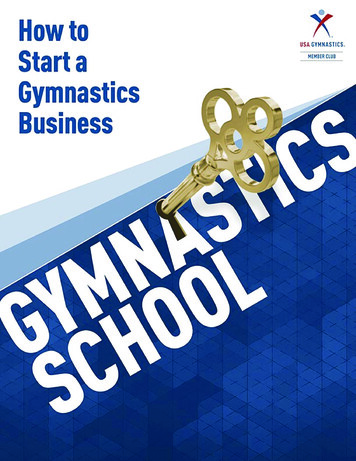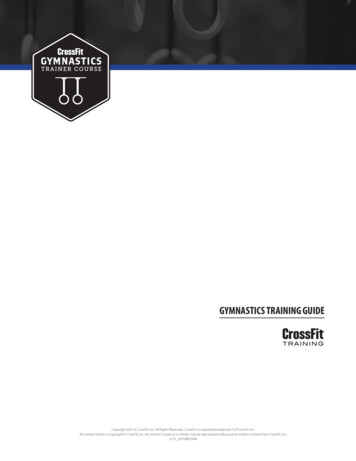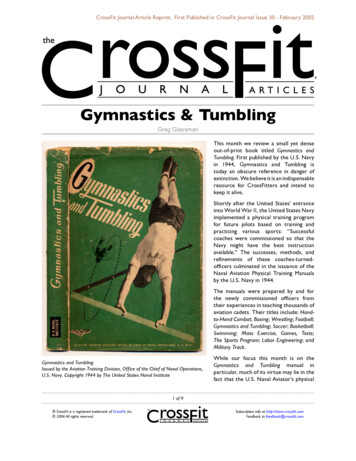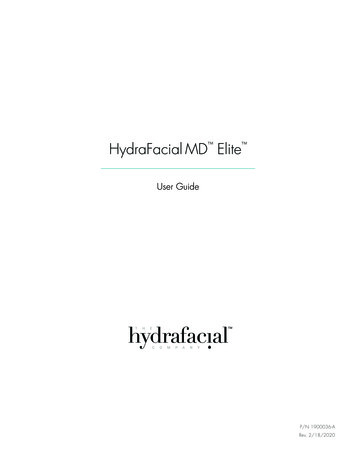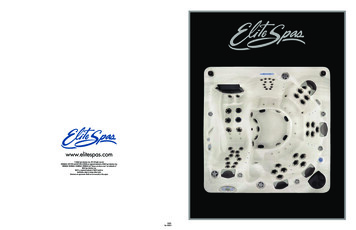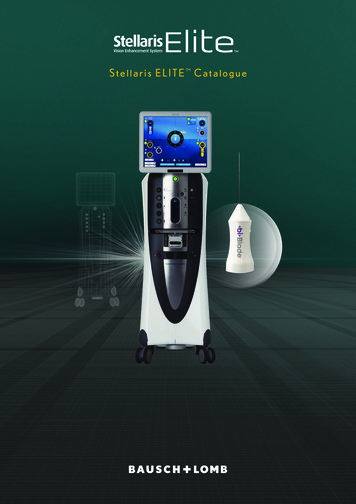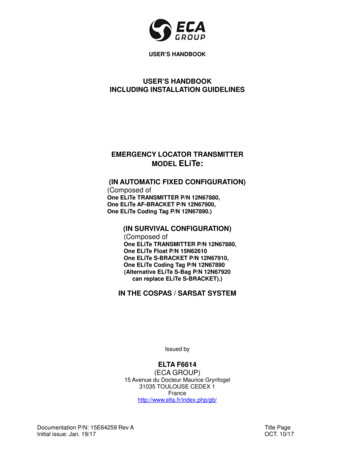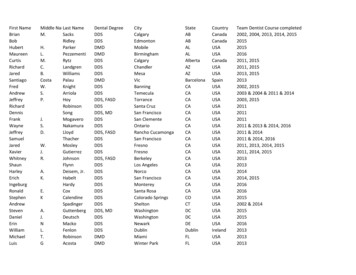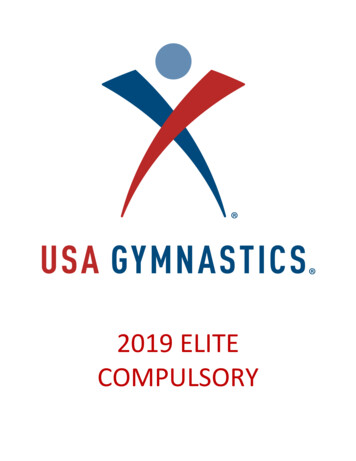
Transcription
2019 ELITECOMPULSORY
2019-2020 OFFICIAL Elite Compulsory – VAULTUpdated and approved by the IEC—9-23-19—from the Judges’ CourseUpdated and approved by the IEC—1-23-20Please note: All vaults will be valued at a 10.00. The coach announces the vault including the body position (tuck, pike, layout). The judges evaluate the actual vault seen, not necessarily what is announced by the coach. There is no deduction for performing a different vault that was announced. The figures are a GUIDELINE for understanding the vault. Techniques may vary in terms of timing. The evaluation emphasis will be on technique, form, execution, and body shape throughout themajor elements. Only One (1) vault is permitted. The vault entry and shape must be announced. The gymnast may choose from any of the FOUR entrances and perform the vault in one (1) of thethree (3) body positions. (TUCK, PIKE, STRETCH) The vault may be performed in a “pit” with a resi-surface of level matting over loose foam. The height of the landing must be at FIG competition level. Several layers of mats may be stackedto comply with the FIG specifications. The height of the table must be according to FIG apparatus specifications. Refer to USAGymnastics Rules and Policies. General deductions and judging guidelines are listed at the end of this document. If, after the completion of the last event, an athlete’s AA score is a maximum of 0.10 less than thequalifying score to Hopes Classic, American Classic, and US Classic (NOT applicable to HopesChampionships or US Championships), the coach may submit an inquiry for the gymnast’s lowestscoring event in order that the athlete be considered for qualification purposes. Any change ofscore is official and is included in the final results.The gymnast is allowed Two (2) attempts to perform One (1) vault . (For example: Performs a “runby” on the first vault, the gymnast is allowed a second attempt. Follow the JO “Balk” rules.) Elite Compulsory Vault – Page 1
1a. FRONT HANDSPRING ENTRANCE WITH FORWARD SALTOTUCK (10.00)PIKE (10.00)STRETCH (10.00)Elite Compulsory Vault – Page 2
1b. TSUKAHARA ENTRANCE WITH BACKWARD SALTOTUCK (10.00)PIKE (10.00)STRETCH (10.00)Elite Compulsory Vault – Page 3
1c. YURCHENKO ENTRANCE WITH BACKWARD SALTOTUCK (10.00)PIKE (10.00)STRETCH (10.00)Elite Compulsory Vault – Page 4
1d. YURCHENKO ½ (180 ) TURN - ON ENTRANCE WITH FORWARD SALTOTUCK (10.00)PIKE (10.00)STRETCH (10.00)Elite Compulsory Vault – Page 5
up to 0.10FIRSTFLIGHTPHASEup to 0.20up to 0.30up to 0.20up to 0.20up to 0.30up to 0.10SUPPORT /REPULSIONPHASEup to 0.20up to 0.20up to 0.20up to 0.30up to 0.30up to 0.50up to 0.10up to 0.10up to 0.20up to 0.30up to 0.30SECONDFLIGHTPHASEup to 0.30up to 0.30up to 0.30up to 0.250.300.10up to 0.20INCORRECT FOOT FORM (flexed / sickled)INCORRECT LEG FORMLegs SeparatedLegs BentPOOR TECHNIQUEHip AngleArched BodyINCOMPLETE LA TURNPOOR TECHNIQUEStaggered / Alternate Hand Placement on all Vaults,Except Tsukahara entranceShoulder AngleArched BodyAlternate Repulsion from Hands on all Vaults,Except Tsukahara entranceLegs Bent (in support) or Early Tuck (Salto Vaults)PRESCRIBED LA TURN BEGUN TOO EARLYBENT ARMS (bent 90 or more maximum deduction)slight lead-arm bend allowed on Tsukahara VaultsINCORRECT FOOT FORM (flexed / sickled)INCORRECT LEG FORMLegs CrossedLegs SeparatedLegs BentINSUFFICIENT EXACTNESS OF BODY POSITIONInsufficient TUCK min. 90 bend in hip & kneesExcept twists in tuck position, allow open “puck” positionInsufficient PIKE min. 90 bend in hips91 – 135 insufficient pikeInsufficient STRETCH 180 (ideal)Greater than 135 is considered stretched positionHip Angle 136 – 179 Insufficient Stretch position orArched Body PositionFAILURE TO MAINTAIN STRETCHED BODY(pike down of stretched Vaults to facilitate landing)INSUFFICIENT EXTENSION (OPEN) Before LandingInsufficient and / or Late Extension (Tuck / Pike Vaults)Total Absence of Extension (Tuck / Pike Vaults)UNDER-ROTATION OF SALTO VAULTSBRUSH or HIT OF BODY ON TABLE during Post-FlightElite Compulsory Vault – Page 6
up to 0.30INSUFFICIENT LENGTHWhen evaluating length, consider size of the Gymnast, type of Vault,where the hands contact the Table, where the feet land and overalltrajectory (amplitude) of the 2nd flight phase; not just the distance fromwhere the Gymnast lands in relation to the end of the Vault Table.up to 0.50LANDINGandGeneralup to 0.20No deductionup to 0.30up to 0.300.30VOIDINSUFFICIENT HEIGHTINCORRECT BODY POSTURE ON LANDINGTAKING UP TO 3 STEPS AFTER LANDINGDEVIATION FROM A STRAIGHT DIRECTION,determined by initial contact with the matINSUFFICIENT DYNAMICSFALL UPON LANDINGFAILURE TO LAND ON FEET FIRSTElite Compulsory Vault – Page 7
2019-2020 OFFICIAL Elite Compulsory – UNEVEN BARSUpdated and approved by the IEC—9-23-19—from the Judges’ CourseUpdated and approved by the IEC—1-23-20Please note: The figures are a GUIDELINE to assist with learning the routines. There is flexibility within the textof the routines to allow for choices in technique. NOT ALL of the choices are shown in the pictures.When in doubt, follow the written word of the text. The evaluation emphasis will be on technique, form, execution, and body shape throughout themajor elements. When elements are listed as “a. b. c.” etc., it means the gymnast has a choice of which element toperform. General deductions and judging guidelines are listed at the end of this document. The direction of ½ (180 ) TURNS may be reversed, and are indicated by an asterisk (*). Skills can be considered for additional bonus if indicated by TWO (2) asterisks (**). Routines must be performed according to FIG apparatus specifications. Refer to USAGymnastics Rules and Policies. If, after the completion of the last event, an athlete’s AA score is a maximum of 0.10 less than thequalifying score to Hopes Classic, American Classic, and US Classic (NOT applicable to HopesChampionships or US Championships), the coach may submit an inquiry for the gymnast’s lowestscoring event in order that the athlete be considered for qualification purposes. Any change ofscore is official and is included in the final results.Starting Position: The gymnast begins from a stand inside the bars (on the mat or a board) facing the lowbar.Elite Compulsory Bars – Page 1
1. GLIDE KIP (0.20), CAST TO HANDSTAND (0.80)Jump from both feet and swing the body forward with legs together (PIKED) or STRADDLED to execute aGLIDE KIP.With the shoulders slightly in front of the bar, immediately execute a CAST TO HANDSTAND with legstogether showing a straight body position with the head neutral at the completion of the HANDSTAND.GLIDE KIP (0.20)Up to 0.10 Insufficient extension of the glide (stretched hip angle)Each Up to 0.30 Bent arms / legsCAST TO HANDSTAND (0.80)Each Up to 0.30Up to 0.200.50Up to 0.20Bent arms / legsLeg separationPerforming a piked or straddled castFailure to maintain straight body throughoutFailure to complete Handstand (Up to vertical)No deduction Up to 10 from Vertical0.10 11 - 20 from Vertical0.20 21 - 30 from Vertical0.30 31 or more from VerticalElite Compulsory Bars – Page 2
2. GLIDE KIP (0.20), CAST TO HANDSTAND WITH (*) ½ (180 ) TURN (1.00)At the completion of the CAST TO HANDSTAND, lower down from vertical to execute a forward GLIDEswing, PIKED or STRADDLED. Maintain flat hips while lowering out of the HANDSTAND (figure 1). At thecompletion of the GLIDE swing, lift the feet to the bar to execute a GLIDE KIP.With the shoulders slightly in front of the bar, immediately execute a CAST TO HANDSTAND WITH ½(180 ) TURN with legs together showing a straight body position with the head neutral with legs together.The technique for ½ (180 ) TURN is optional.GLIDE KIP (0.20)Up to 0.10 Insufficient extension of the glide (stretched hip angle)Each Up to 0.30 Bent arms / legsCAST TO HANDSTAND WITH ½ (180 ) TURN (1.00)Each Up to 0.30Up to 0.200.50Up to 0.20Up to the valueof the elementNo deduction0.05 – 0.100.15 – 0.20Bent arms / legsLeg separationPerforming a piked or straddled castFailure to maintain straight body throughoutFailure to complete Handstand ½ (180 ) TURN in vertical Up to 20 from Vertical21 - 30 from Vertical31 - 45 from Vertical 46 or more from Vertical Failure to perform the ½ (180 ) turnSee General Repeating a Glide Kip Cast Handstand0.25 – 0.300.50Elite Compulsory Bars – Page 3
No deduction for Gymnast falls on Cast Handstand ½ Turn and repeats the element. (Re-startrepetition judging at the point of interruption. Do not deduct for execution errors on the2nd attempt.)3a. CLEAR HIP CIRCLE TO HANDSTAND (0.80), CLEAR HIP CIRCLE TO HANDSTAND(0.80)(**) 0.20 BONUS IF THE 1ST CIRCLE IS DIRECTLY connected to the CAST TOHANDSTAND WITH 1/2 (180 ) TURN. No Bonus will be awarded if a fall occurs.If the CAST TO HANDSTAND WITH 1/2 (180 ) TURN and first CIRCLE SKILL are notdirectly connected, the gymnast is allowed an additional Glide Kip Cast to Handstand withno deduction for adding extra elements. However, appropriate execution deductions will beapplied.Execute a CLEAR HIP CIRCLE, finishing in a HANDSTAND with the body extended. Maintain straightarms and legs throughout.Initiate a second CLEAR HIP CIRCLE, finishing in a HANDSTAND with the body extended. Maintainstraight arms and legs throughout.If the gymnast does not directly connect the two circles and performs a Glide Kip Cast toHandstand BETWEEN the two circles, deduct 0.30 for adding an extra element.Elite Compulsory Bars – Page 4
CLEAR HIP CIRCLE TO HANDSTAND (0.80), CLEAR HIP CIRCLE TOHANDSTAND (0.80)No deduction. Deduct onlyexecution.Each Up to 0.30Each Up to 0.20Each Up to 0.20Each Up to 0.40No deduction0.100.200.300.40Adding a Glide Kip cast Handstand before theClear Hip Circle to HandstandBent arms / legsLaboring or struggling to verticalFailure to maintain straight body throughoutFailure to complete element to Handstand (Up to vertical)Failure to complete Handstand (Up to vertical) Up to 10 from Vertical 11 - 20 from Vertical 21 - 30 from Vertical 31 - 45 from Vertical 46 or more from Vertical3b. STALDER CIRCLE BACKWARD TO HANDSTAND (0.80), STALDER CIRCLEBACKWARD TO HANDSTAND (0.80)(**) 0.20 BONUS IF THE 1ST CIRCLE IS DIRECTLY connected to the CAST TOHANDSTAND WITH 1/2 (180 ) TURN. No Bonus will be awarded if a fall occurs.Elite Compulsory Bars – Page 5
If the CAST TO HANDSTAND WITH 1/2 (180 ) TURN and first CIRCLE SKILL are notdirectly connected, the gymnast is allowed an additional Glide Kip Cast to Handstand withno deduction for adding extra elements. However, appropriate execution deductions will beapplied.Execute a BACKWARD STALDER CIRCLE, finishing in a HANDSTAND with the body extended.Maintain straight arms and legs throughout.Initiate a second BACKWARD STALDER CIRCLE, finishing in a HANDSTAND with the body extended.Maintain straight arms and legs throughout.If the gymnast does not directly connect the two circles and performs a glide kip Cast toHandstand BETWEEN the two circles, deduct 0.30 for adding an extra element.STALDER CIRCLE BACKWARD TO HANDSTAND (0.80), STALDER CIRCLEBACKWARD TO HANDSTAND (0.80)No deduction. Deduct onlyexecution.Each Up to 0.30Each Up to 0.20Each Up to 0.20Each Up to 0.40Adding a Glide Kip cast Handstand before theStalder Circle Backward to HandstandBent arms / legsLaboring or struggling to verticalFailure to attain straight body in verticalFailure to complete element to Handstand (Up to vertical)3c. BACKWARD SOLE CIRCLE TO HANDSTAND (0.80), BACKWARD SOLE CIRCLETO HANDSTAND (0.80)Elite Compulsory Bars – Page 6
(**) 0.20 BONUS IF THE 1ST CIRCLE IS DIRECTLY connected to the CAST TOHANDSTAND WITH 1/2 (180 ) TURN. No Bonus will be awarded if a fall occurs.If the CAST TO HANDSTAND WITH 1/2 (180 ) TURN and first CIRCLE SKILL are notdirectly connected, the gymnast is allowed an additional Glide Kip Cast to Handstand withno deduction for adding extra elements. However, appropriate execution deductions will beapplied.Execute a BACKWARD SOLE CIRCLE, finishing in a HANDSTAND with the body extended. Maintainstraight arms and legs throughout.Initiate a second BACKWARD SOLE CIRCLE, finishing in a HANDSTAND with the body extended.Maintain straight arms and legs throughout.If the gymnast does not directly connect the two circles and performs a glide kip Cast toHandstand BETWEEN the two circles, deduct 0.30 for adding an extra element.BACKWARD SOLE CIRCLE TO HANDSTAND (0.80), BACKWARD SOLECIRCLE TO HANDSTAND (0.80)No deduction. Deduct onlyexecution.Each Up to 0.30Each Up to 0.20Each Up to 0.20Each Up to 0.40Adding a Glide Kip cast Handstand before theBackward Sole Circle to HandstandBent arms / legsLaboring or struggling to verticalFailure to attain straight body in verticalFailure to complete element to Handstand (Up to vertical)3d. CLEAR PIKED BACKWARD SOLE CIRCLE TO HANDSTAND (0.80), CLEAR PIKEDBACKWARD SOLE CIRCLE TO HANDSTAND (0.80)Elite Compulsory Bars – Page 7
(**) 0.20 BONUS IF THE 1ST CIRCLE IS DIRECTLY connected to the CAST TOHANDSTAND WITH 1/2 (180 ) TURN. No Bonus will be awarded if a fall occurs.If the CAST TO HANDSTAND WITH 1/2 (180 ) TURN and first CIRCLE SKILL are notdirectly connected, the gymnast is allowed an additional Glide Kip Cast to Handstand withno deduction for adding extra elements. However, appropriate execution deductions will beapplied.Execute a CLEAR PIKED BACKWARD SOLE CIRCLE, finishing in a HANDSTAND with the bodyextended. Maintain straight arms and legs throughout.Initiate a second CLEAR PIKED BACKWARD SOLE CIRCLE, finishing in a HANDSTAND with the bodyextended. Maintain straight arms and legs throughout.If the gymnast does not directly connect the two circles and performs a glide kip Cast toHandstand BETWEEN the two circles, deduct 0.30 for adding an extra element.CLEAR PIKED BACKWARD SOLE CIRCLE TO HANDSTAND (0.80), CLEARPIKED BACKWARD SOLE CIRCLE TO HANDSTAND (0.80)No deduction. Deductonly execution.Each Up to 0.30Each Up to 0.20Each Up to 0.20Each Up to 0.40Adding a Glide Kip cast Handstand before the Clear Piked BackwardSole Circle to HandstandBent arms / legsLaboring or struggling to verticalFailure to attain straight body in verticalFailure to complete element to Handstand (Up to vertical)3e. TWO (2) DIFFERENT CIRCLE ELEMENTS FROM ABOVE (3a or 3b or 3c or 3d)(Each 0.80) Refer to 3a, 3b, 3c, 3d for illustrations.Elite Compulsory Bars – Page 8
(**) 0.20 BONUS IF THE 1ST CIRCLE IS DIRECTLY connected to the CAST TOHANDSTAND WITH 1/2 (180 ) TURN. No Bonus will be awarded if a fall occurs.If the CAST TO HANDSTAND WITH 1/2 (180 ) TURN and first CIRCLE SKILL are notdirectly connected, the gymnast is allowed an additional Glide Kip Cast to Handstand withno deduction for adding extra elements. However, appropriate execution deductions will beapplied.(**) 0.20 ADDITIONAL BONUS for DIRECTLY CONNECTING Two (2) DIFFERENTCIRCLE ELEMENTSIf the gymnast does not directly connect the two circles and performs a glide kip Cast toHandstand BETWEEN the two circles, deduct 0.30 for adding an extra element.No Bonus will be awarded if a fall occurs or when CIRCLE SKILLS are not directlyconnected.4. BACKWARD SOLE CIRCLE (0.40), LONG HANG KIP (0.20), CAST TO HANDSTAND(0.80)If not directly connected from the Circle element, the gymnast is allowed an additional GlideKip Cast to Handstand with no deduction for adding extra elements. However, appropriateexecution and amplitude deductions of the Cast will be applied.Execute a BACKWARD SOLE CIRCLE.From the pike position on the low bar, immediately jump forward to execute a LONG HANG KIP.Elite Compulsory Bars – Page 9
With the shoulders slightly in front of the bar, immediately execute a CAST TO HANDSTAND with legstogether showing a straight body position with the head neutral at the completion of the HANDSTAND.BACKWARD SOLE CIRCLE (0.40)No deduction. Deduct Adding a Glide Kip cast Handstand before theonly execution. Backward Sole Circle0.20 Bent legs before the completion of the circleLONG HANG KIP (0.20)Up to 0.10 Insufficient extension of forward swing (stretched hip angle)Each Up to 0.30 Bent arms / legsCAST TO HANDSTAND (0.80)Each Up to 0.30Up to 0.200.50Up to 0.20Bent arms / legsLeg separationPerforming a straddled castFailure to maintain straight body throughoutFailure to complete element to Handstand (Up to vertical)No deduction Up to 10 from Vertical0.10 11 - 20 from Vertical0.20 21 - 30 from Vertical0.30 31 or more from Vertical5a. BACKWARD GIANT CIRCLE TO HANDSTAND WITH (*) ½ (180 ) TURN (1.00)While maintaining an open the shoulder angle, push backward, maintaining a hollow-body position as thedownward-forward swing begins. The legs are allowed to remain together or straddled on the downwardswing. Either above the low bar OR as the feet pass the low bar, relax the hollow position to an arch.Maintain this arched position through the bottom (under the high bar) and aggressively kick forwardupward toward vertical to execute a BACKWARD GIANT CIRCLE TO HANDSTAND. The head remainsElite Compulsory Bars – Page 10
neutral. Either BEFORE or IN vertical, execute a ½ (180 ) TURN in either direction to finish in an undergrip (reverse) or “L” grip. The completion of the turn must be in the vertical.BACKWARD GIANT CIRCLE TO HANDSTAND WITH (*) ½ (180 ) TURN (1.00)Each Up to 0.300.20Up to 0.20Up to 1.00Bent arms / legsFailure to show open hips in the bottom of the swing (piked)Failure to finish with a straight body in verticalFailure to complete element through handstand to include the ½ (180 ) Turn(value of element)Horizontal 0.50 i.e. Back Giant ½ turn to Horizontal (Swing ½ turn)0.50 Failure to perform the ½ (180 ) turn i.e. Backward Giant to handstand withno attempt to turnFailure to complete ½ (180 ) TURN in vertical (finishes after vertical)No deduction Up to 20 from Vertical0.05 – 0.10 21 - 30 from Vertical0.15 – 0.200.25 – 0.30 31 - 45 from Vertical46 or more from Vertical5b. CLEAR HIP CIRCLE TO HANDSTAND WITH (*) ½ (180 ) (1.00)Execute a CLEAR HIP CIRCLE, finishing in a HANDSTAND with the body extended. Maintain straightarms and legs throughout.Either BEFORE or IN vertical, execute a ½ (180 ) TURN in either direction to finish in an under-grip(reverse) or “L” grip. The completion of the turn must be in the vertical.Elite Compulsory Bars – Page 11
CLEAR HIP CIRCLE TO HANDSTAND WITH ½ (180 ) TURN (1.00)Each Up to 0.30 Bent arms / legsUp to 0.20 Failure to finish with a straight body in verticalUp to 1.00 Failure to complete element through handstand to include the ½ (180 ) Turn(value of element) i.e. Clear hip circle to handstand with ½ turn, does not go through the vertical0.50 Failure to perform the ½ (180 ) turni.e. Clear hip circle to handstand with no attempt to turnFailure to complete ½ (180 ) TURN in vertical (finishes after vertical)No deduction Up to 20 from Vertical0.05 – 0.10 21 - 30 from Vertical0.15 – 0.20 31 - 45 from Vertical0.25 – 0.30 46 or more from Vertical5c. STALDER CIRCLE BACKWARD TO HANDSTAND WITH (*) ½ (180 ) TURN (1.00)Execute a BACKWARD STALDER CIRCLE, finishing in a HANDSTAND with the body extended.Maintain straight arms and legs throughout.Either BEFORE or IN vertical, execute a ½ (180 ) TURN in either direction to finish in an under-grip(reverse) or “L” grip. The completion of the turn must be in the vertical.Elite Compulsory Bars – Page 12
STALDER CIRCLE BACKWARD TO HANDSTAND WITH ½ (180 ) TURN (1.00)Each Up to 0.30 Bent arms / legsUp to 0.20 Failure to finish with a straight body in verticalUp to 1.00 Failure to complete element through handstand to include the ½ (180 ) Turn(value of element) i.e. Stalder Circle Backward to handstand with ½ turn, does not go throughthe vertical0.50 Failure to perform the ½ (180 ) turni.e. Stalder Circle Backward to handstand with no attempt to turnFailure to complete ½ (180 ) TURN in vertical (finishes after vertical)No deduction Up to 20 from Vertical0.05 – 0.10 21 - 30 from Vertical0.15 – 0.20 31 - 45 from Vertical0.25 – 0.30 46 or more from Vertical5d. BACKWARD SOLE CIRCLE TO HANDSTAND WITH (*) ½ (180 ) TURN (1.00)Execute a BACKWARD SOLE CIRCLE, finishing in a HANDSTAND with the body extended. Maintainstraight arms and legs throughout.Either BEFORE or IN vertical, execute a ½ (180 ) TURN in either direction to finish in an under-grip(reverse) or “L” grip. The completion of the turn must be in the vertical.Elite Compulsory Bars – Page 13
BACKWARD SOLE CIRCLE TO HANDSTAND WITH ½ (180 ) TURN (1.00)Each Up to 0.30 Bent arms / legsUp to 0.20 Failure to finish with a straight body in verticalUp to 1.00 Failure to complete element through handstand to include the ½ (180 ) Turn(value of element) i.e. Backward Sole Circle to Handstand with ½ turn, does not go through thevertical0.50 Failure to perform the ½ (180 ) turni.e. Backward Sole Circle to Handstand with no attempt to turnFailure to complete ½ (180 ) TURN in vertical (finishes after vertical)No deduction Up to 20 from Vertical0.05 – 0.10 21 - 30 from Vertical0.15 – 0.20 31 - 45 from Vertical0.25 – 0.30 46 or more from Vertical5e. PIKED CLEAR BACKWARD SOLE CIRCLE TO HANDSTAND WITH (*) ½ (180 )TURN (1.00)Execute a BACKWARD SOLE CIRCLE, finishing in a HANDSTAND with the body extended. Maintainstraight arms and legs throughout.Either BEFORE or IN vertical, execute a ½ (180 ) TURN in either direction to finish in an under-grip(reverse) or “L” grip. The completion of the turn must be in the vertical.Elite Compulsory Bars – Page 14
PIKED CLEAR BACKWARD SOLE CIRCLE TO HANDSTAND WITH ½ (180 )TURN (1.00)Each Up to 0.30 Bent arms / legsUp to 0.20 Failure to finish with a straight body in verticalUp to 1.00 Failure to complete element through handstand to include the ½ (180 ) Turn(value of element) i.e. Piked Clear Backward Sole Circle to Handstand with ½ turn, does not gothrough the vertical0.50 Failure to perform the ½ (180 ) turni.e. Piked Clear Backward Sole Circle to Handstand with no attempt to turnFailure to complete ½ (180 ) TURN in vertical (finishes after vertical)No deduction Up to 20 from Vertical0.05 – 0.10 21 - 30 from Vertical0.15 – 0.20 31 - 45 from Vertical0.25 – 0.30 46 or more from Vertical6. FORWARD GIANT CIRCLE TO HANDSTAND (0.80), FORWARD GIANT CIRCLE TOHANDSTAND WITH (*) ½ (180 ) TURN (1.00)The FORWARD GIANT CIRCLES may be performed in under-grip (reverse) or “L” grip.Elite Compulsory Bars – Page 15
Elite Compulsory Bars – Page 16
While maintaining an open the shoulder angle, push forward, maintaining an extended body position as thedownward-backward swing begins. The legs must remain together throughout the entire CIRCLE. Leadingwith the heels, slightly pike in the hips (enough to clear the low bar) above the low bar.Maintain this pike position through the bottom (under the high bar) and aggressively kick backward-upwardtoward vertical to execute a FORWARD GIANT CIRCLE TO HANDSTAND. The head remains neutral.Push forward, maintaining an extended body position to initiate a second FORWARD GIANT CIRCLE,finishing in a HANDSTAND with the body extended. Maintain straight arms and legs throughout.Either BEFORE or IN vertical, execute a ½ (180 ) TURN in either direction to finish in an over-grip (regular)grip. The completion of the turn must be in the vertical.Elite Compulsory Bars – Page 17
FORWARD GIANT CIRCLE TO HANDSTAND (0.80)Only execution Performing a cast to handstand after a fall on the previous skilldeductionsUp to the value Failure to complete element to Handstand on Forward Giant Circle toof the element HandstandHorizontal 0.50Each Up to 0.30Up to 0.20Each 0.30Each 0.50Up to 0.20Each Up to 0.20Bent arms / legsFailure to show open shoulders throughoutLegs straddle on downswingLegs straddle or hips piked on upswingFailure to finish with a straight body in verticalLaboring or struggling to verticalFORWARD GIANT CIRCLE TO HANDSTAND WITH ½ (180 ) TURN (1.00)Up to 0.50 Failure to perform Forward Giant Circle to Handstand0.50 Swings only to Horizontal0.50 Gymnast performs the Front Giant to Handstand to any angle, but does notperform the ½ turn.Failure to complete ½ (180 ) TURN in vertical (finishes after vertical)No deduction Up to 20 from Vertical0.05 – 0.10 21 - 30 from Vertical0.15 – 0.20 31 - 45 from Vertical0.25 – 0.30 46 or more from Vertical0.30 Performing a Cast Handstand with ½ (180 ) Turn after a failed attempt at thePlus execution Front Giant Circle to Handstand with 180 turn. (Adding an element)7. BACKWARD GIANT CIRCLE TO HANDSTAND (0.80)Elite Compulsory Bars – Page 18
While maintaining an open the shoulder angle, push backward, maintaining a hollow-body position as thedownward-forward swing begins. The legs are allowed to remain together or straddled on the downwardswing. Either above the low bar OR as the feet pass the low bar, relax the hollow position to an arch.Maintain this arched position through the bottom (under the high bar) and aggressively kick forwardupward toward vertical to execute a BACKWARD GIANT CIRCLE TO HANDSTAND. The head remainsneutral. The technique performing the element as an “accelerated GIANT CIRCLE” with a hollow bodyshape through vertical is acceptable.BACKWARD GIANT CIRCLE TO HANDSTAND (0.80)Each Up to 0.300.20Up to 0.20Up to 0.40Bent arms / legsFailure to show open hips in the bottom of the swing (piked)Failure to finish with a straight body in verticalFailure to complete element to Handstand (Up to vertical)8a. FLYAWAY STRETCHED / HOLLOW DISMOUNT (1.00)Additional matting is suggested.While maintaining an open the shoulder angle, push backward, maintaining a hollow-body position as thedownward-forward swing begins. The legs are allowed to remain together or straddled on the downwardswing. Either above the low bar OR as the feet pass the low bar, relax the hollow position to an arch.Maintain this arched position through the bottom (under the high bar) and aggressively kick forwardupward with legs/feet together to a hollow-body position with the head neutral, focusing on the toes.Elite Compulsory Bars – Page 19
As the feet approach the level of the high bar, release the bar with an open shoulder angle, maintaining aneutral head position. The body continues to rise to execute a FLYAWAY DISMOUNT, with the hipsperformed at a minimum of high bar height in a STRETCHED / HOLLOW POSITION. Land on the backonto stack mats or into a pit surface OR Land on both feet in demi-plié.Upon landing: A coach is allowed to assist (spot) the landing.FLYAWAY STRETCHED / HOLLOW DISMOUNT (1.00)Up to 0.30 Bent legs0.20 Failure to show open hips in the bottom of the swing (piked)Up to 0.50 Failure to maintain straight or hollow body throughout (no arch allowed)Up to 0.30 Insufficient height of FLYAWAY (hips should be above bar height)LANDING DEDUCTIONS-Evaluated based only on body position at the point of arrival onthe mat.Up to 0.20 Incorrect posture on landingNo deduction Backward motion or over rotation to the back is allowedNo deduction Coach spots on landing8b. DOUBLE FLYAWAY STRETCHED / HOLLOW DISMOUNT (1.00)Additional matting is suggested.Elite Compulsory Bars – Page 20
Note: The gymnast is allowed to perform Two (2) BACKWARD GIANT CIRCLES prior to the DOUBLEFLYAWAY STRETCHED / HOLLOW without receiving a deduction for the additional skill. However,appropriate execution deductions will be applied.While maintaining an open the shoulder angle, push backward, maintaining a hollow-body position as thedownward-forward swing begins. The legs are allowed to remain together or straddled on the downwardswing. Either above the low bar OR as the feet pass the low bar, relax the hollow position to an arch.Maintain this arched position through the bottom (under the high bar) and aggressively kick forwardupward with legs/feet together to a hollow-body position with the head neutral, focusing on the toes.As the feet approach the level of the high bar, release the bar with an open shoulder angle, maintaining aneutral head position. The body continues to rise to execute a DOUBLE FLYAWAY STRETCHEDDISMOUNT, with the hips performed at a minimum of high bar height in a STRETCHED / HOLLOWPOSITION. Land on both feet in demi-plié.Upon landing: A coach is allowed to assist (spot) the landing.DOUBLE FLYAWAY STRETCHED / HOLLOW DISMOUNT (1.00)Up to 0.30 Bent legs0.20 Failure to show open hips in the bottom of the swing (piked)Up to 0.50 Failure to maintain straight or hollow body throughout (no arch allowed)Up to 0.30 Insufficient height of DOUBLE FLYAWAY (hips should be above bar height)LANDING DEDUCTIONS-Evaluated based only on body position at the point of arrival onthe mat.Up to 0.20 Incorrect posture on landingNo deduction Backward motion or over rotation to the back is allowedNo deduction Coach spots on landingElite Compulsory Bars – Page 21
UNEVEN BARSGeneral Deductions / Judging GuidelinesRefer to the JO Code of Points for additional GeneralExecution DeductionsDeductions for form / execution MAY NOT exceed the assigned Value of the Element. Fallswill be in addition to execution errors.A clear attempt at a BONUS element / connection regardless of execution errors WILLreceive BONUS. NO BONUS will be awarded if there is a FALL.0.50Value of the elementPLUS 0.50Up to the value of theelement0.30FallsOmitting an elementIncomplete element. See individual boxes for specifics.Adding an element (when not allowed) or performing elements out oforderValue of the element Spotting to assist the completion of an elementplus 0.50 for the spot0.200.30No deductionfor repetitionEach 0.30Verbal coaching an athlete during a routine.Not performing the routine according to FIG apparatus specificationsRepeating element(s) after a FALL (i.e. Cast Handstand-FALL pastvertical, Cast Handstand, Backward Giant)Repeating an element without a FALL (i.e. Glide Kip-Cast Handstand,Glide Kip-Cast Handstand, Glide Kip-Cast Handstand ½ turn)Only count Glide Kip Cast
Elite Compulsory Vault - Page 1 2019-2020 OFFICIAL Elite Compulsory - VAULT Updated and approved by the IEC—9-23-19—from the Judges' Course Updated and approved by the IEC—1-23-20 Please note: All vaults will be valued at a 10.00. The coach announces the vault including the body position (tuck, pike, layout).
